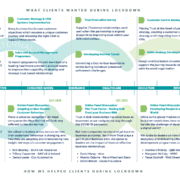Satisfaction or ‘Statisfaction’?
One of my esteemed colleagues recently sent a draft document to me that had a typo – satisfaction had been spelt with an extra ‘t’, making up a new word ‘statisfaction’.
That got me thinking!
I have been involved in numerous movements and initiatives to drive customer-focused business improvement for over 25 years – from Total Quality & Customer Satisfaction (CSat) through to Net Promoter Score (NPS) and Customer Relationship Quality (CRQ).
One thing that I have learned working with hundreds of companies across the world is that:
IT’S NOT ABOUT THE SCORE – IT’S ABOUT THE CUSTOMERS
Businesses like things quantified (there’s a perception that companies are run by accountants nowadays?), and on the whole I go along with the “what gets measured gets managed” mantra (see below), so I fully endorse customer experience and internal capability measurement.
I also like statistics! I’m intrigued by the fact that (as happened recently in a client) the average score of the Net Promoter question can go up but the NPS itself goes down! I love exploring how ‘the same’ internal capability score can be made up of completely different profiles of strength, weakness, consistency and impact across the organisation.
The first trouble with ‘the numbers’ (scores, averages, top-box, etc.) is that they DE-HUMANISE their source – our customers and how we manage their experience and value.
Yes, verbatims that are often included in the appendices of research reports and are summarised into frequency graphs of positive & negative sentiment (quantification again!), but I really wonder how many executives actually read every customer comment?
My point here is that customers are on a JOURNEY, and have a STORY to tell, but organisationally we’re only interested in a number.
My second problem with ‘the numbers’ is that hitting the score target can easily become the objective in itself rather than improving organisational capabilities. I have seen this lead to many counter-cultural, and indeed downright destructive, behaviours:
-Deselection of unhappy or difficult customers from surveys
-Writing new strategies instead of implementing the one you’ve got
-NPS begging – “please give me a 9 or 10 or I’ll get fired”
-Only ever addressing ‘quick wins’ – never the underlying systemic issues
-Blaming sample sizes and methodologies as an excuse for inactivity
-Blatant attempts to fix the scores (e.g. fabricated questionnaire completions, ‘evidence’ of capability that is in fact just a Powerpoint slide)
-Corporate tolerance of low-scorers – many companies seem content with the fact that large proportions of their customers hate them!
-Putting metrics into performance scorecards but with such a low weighting (vs. sales) that nobody really cares
-Improving “the process” instead of “the journey”
-No follow-up at a personal level because of research anonymity; or inconsistent follow-up if anonymity is waived – often only of low scorers treated as complainants – what about thanking those who compliment and asking for referrals from advocates?
I could go on, but I hope the point is made – beware of “what gets measured gets managed” becoming:
“WHAT GETS MEASURED GETS MANIPULATED”
So instead of targeting statistical scores, seek to find ways of improving your systemic capabilities to cost-effectively manage your customer experience – and then listen to what they’re saying to you about how satisfying it is.
By the way, your scores will improve too!
If you’d like to find out more about how CRQ™ overcomes these issues in B2B voice of the customer programmes, please contact Peter Lavers here.
- Customer Strategy in the B2B Membership Sector - May 27, 2025
- Build a B2B Customer Strategy - May 20, 2025
- Should you implement NPS in B2B? - January 22, 2025





